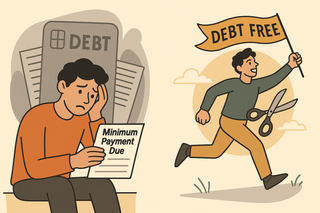It’s a common trap: You make your minimum credit card payment every month, but somehow… your balance barely moves.
You’re doing your part, right? So why is it more difficult to get out of debt when only paying the minimum payment?
The short answer: interest, and lots of it.
The long answer: You're not just paying for what you borrowed — you're paying for the time you take to repay it. And that time costs money.
In this article, we’ll explain exactly how minimum payments work, why they keep you in debt longer, and what to do instead to break free — for good.
What Is a Minimum Payment?
The minimum payment is the smallest amount your credit card company will accept to keep your account in good standing each month.
Typically, this is:
-
1% to 3% of your balance, or
-
A flat fee (e.g., $25), whichever is higher
But what seems manageable in the short term is actually a costly long-term strategy.
Why Is It More Difficult to Get Out of Debt When Only Paying the Minimum Payment?
Let’s break it down:
💣 1. Most of Your Payment Goes to Interest — Not Principal
When you pay just the minimum, the majority of your payment goes toward interest, not reducing your actual balance (the “principal”).
That means:
-
Your balance shrinks very slowly
-
You end up paying much more over time
-
You’re stuck in debt far longer than expected
Example:
Let’s say you owe $5,000 at 20% APR and only make the minimum payment (2% of balance = $100/month):
| Factor | Result |
| Time to Pay Off |
~279 months (over 23 years!)
|
| Total Interest Paid | ~$9,000 |
| Total Cost |
~$14,000 on a $5,000 balance 😱
|
Now you see why it's so difficult to escape debt when paying the bare minimum.
🔁 2. New Charges Add to the Debt Spiral
If you continue using the card while paying only the minimum, the balance keeps growing.
You’re chasing your tail — never really catching up, and the interest keeps stacking.
🛑 3. You Miss the Power of Compounding — In Reverse
Compounding works for you when you invest.
It works against you when you owe.
Each month your unpaid balance grows, and next month’s interest is calculated on that bigger number — not the original amount.
Over time, interest charges snowball and keep you trapped.
Learn how to flip the script by letting money work for you here: Why Investing Is a More Powerful Tool to Build Long-Term Wealth Than Saving
The Psychology of Minimum Payments
Credit card companies design statements to make the minimum look “good enough.”
Why? Because they make more profit the longer you stay in debt.
It’s psychologically easier to pay $50/month than $300/month — but the long-term cost is massive.
Minimum payment ≠ progress. It’s just delay.
What to Do Instead: Smart Strategies to Get Out of Debt Faster
Here’s how to take control:
✅ 1. Always Pay More Than the Minimum
Even an extra $50–$100 per month can cut years off your repayment timeline and save thousands in interest.
✅ 2. Use the Debt Snowball or Avalanche Method
-
Snowball: Pay off smallest debts first → builds motivation
-
Avalanche: Pay off highest interest debts first → saves more money
Choose the method that fits your mindset and goals.
✅ 3. Stop Adding New Charges
This is crucial. Put the card away, pause spending, and focus on reducing what you already owe.
✅ 4. Consider a Balance Transfer
A 0% APR balance transfer card can help consolidate debt and avoid interest for a limited time.
Just watch for fees and deadlines.
✅ 5. Negotiate Lower Interest Rates
Call your credit card issuer and ask. If you’ve been a good customer, they might reduce your rate — especially if you mention looking at other options.
✅ 6. Build a Budget
Get real about where your money is going. Use a zero-based budget or the 50/30/20 rule.
Learn the basics in Low-Stress Jobs That Pay Well Without a Degree — because sometimes increasing income helps more than cutting back.
✅ 7. Track Progress
Use an app or spreadsheet to watch your balances shrink.
Progress is fuel for motivation!
What If You’re Just Starting Out?
Understanding debt now can save you from years of struggle later.
Check out How to Fill Out a Check: A Complete Step-by-Step Guide to build strong money habits from the ground up.
Smart Financial Lifestyle: Helping You Break Free from Debt
At Smart Financial Lifestyle, we believe debt shouldn’t control your life.
We’re here to help you:
-
Understand how debt works
-
Avoid traps like minimum payment spirals
-
Build habits that lead to long-term freedom
-
Learn from mistakes like those in The Biggest Mistake Parents Make Setting Up a Trust Fund
Final Takeaway: Minimum Payments = Maximum Trouble
Why is it more difficult to get out of debt when only paying the minimum payment?
Because it’s not designed to help you win — it’s designed to help lenders profit.
The good news?
Now that you understand the trap, you can avoid it, escape it, and build the financial future you deserve.
